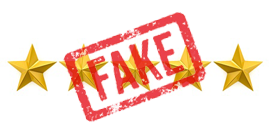
The 5 Parts: Fake Reviews
Part 1: What is a Fake Review, and Why Should You Care? (You are here)
Part 2: Peeling Away The Dark Side Of Internet Marketing
Part 3: Spot ’em and Stop ’em!
Part 4: Tired of Fake Reviews? Let’s Steer a Different Path!
Part 5: Beat the Fake – How to Gather Authentic Reviews for Your Business
 Let’s you and I play a game of “Whack-a-Mole.”
Let’s you and I play a game of “Whack-a-Mole.”
I know — you think this is an article about how to get great reviews for your online business, right?
Stay with me on this.
Take a look at this statement on the information page of a hotel:
Please know that despite the fact that wedding couples love Hudson and our inn, your friends and families may not. If you have booked the inn for a wedding or other type of event and given us a deposit of any kind … there will be a $500 fine that will be deducted from your deposit for every negative review placed on any internet site by anyone in your party.
If you stay here to attend a wedding anywhere in the area and leave us a negative review on any internet site you agree to a $500 fine for each negative review.
If you take down the nasty review, you’ll get your money back.
Wow! Did I just make this up? Is it fake news?
Nope. This was the official policy of a real hotel in Hudson, New York. Apparently the owners felt it was a great way to get glowing recommendations.
Here’s how it worked. Every time someone popped up with a negative review, the owners got that trusty mallet out and beat the person over the head. Here’s what that looked like:
“Please note that your recent on-line review of our Inn will cost the wedding party that left us a deposit $500. This money will be charged via the deposit they have left us unless/until it is removed. Any other or future reviews will also be charged to the wedding party (bride & groom) from the guarantee they have provided us.”
Wham! Whack ‘em down! It’s not even penalizing the reviewer, but the guys whose event it was!
 That’ll teach them to write negative reviews!
That’ll teach them to write negative reviews!
Except…
Perhaps not surprisingly, the “moles” — aka customers — fought back.
The story of young newlyweds threatened with the loss of their deposit if their guests wrote bad reviews went viral.
The business was flooded with negative reviews. Over 3 thousand of them, all one star. They were closely followed by negative press releases — dozens of them, from all over the world.
The end result? In just a few months, the hotel was forced to close down.
The lesson for us all? Threatening customers to get positive reviews is a sure way to see your business close down!
So, what’s a better way? And is it really worth all the hassle?
Why Bother?
Let’s be honest: getting reviews means work. And it can be hard work. How to ask for them without either begging or threatening, how to sift out the fakes, how to deal with the less than favorable comments, how to use any reviews without feeling “salesy”…
It can feel like a nightmare.
So here’s the first question you need to consider: why bother even trying to get reviews of your business or your product(s)?
In the first of our articles delving into the murky world of fake reviews, we looked at the evidence that online endorsements are key in the decision-making process:
“America’s Federal Trade Commission found that over 70% of consumers read product reviews before buying. In a 2016 survey, as many as 84% said they trust an online review as much as they would trust a personal recommendation from a friend — a rise from 80% in 2015.”
And those figures cover every niche. Reviews are no longer important only for that beautiful hotel you stayed in or the dreadful meal you ate.
Your customer’s voice is equally important whether you’re selling your own product or recommending an affiliate’s; whether you have an informational blog or a brick and mortar store; whether you’re a tiny operation with just you as an employee or a large corporate conglomerate.
In every business, reviews are now an expectation, not an option. Authentic reviews establish trust between business and customer.
So, if you’re in the business of selling anything — your knowledge, your services, your products (or other people’s) — high quality, honest reviews are critical to your success.
Are Even Negative Reviews Important?
Notice I said: “high quality, honest reviews.” I purposely didn’t say “positive reviews.”
Why?
 Let’s look at Bill Gates’s take on that:
Let’s look at Bill Gates’s take on that:
“Your most unhappy customers are your greatest source of learning”
The best way to achieve great reviews, of course, is to provide an excellent product coupled with an exceptional level of customer service. Make sure your customers are happy and super reviews are likely to follow.
But what about when they’re not happy? Of course, you would never threaten to withhold a payment in the manner of the Hudson hotel (you’d never do that — right?).
But is your first instinct to delete a negative online review? Or to throw it in the bin, if it comes in offline? Pretend it never happened?
Or worse — are you tempted to get defensive — aggressive, even? Start a war of words with the customer, which can only spiral downwards?
It’s hard not to feel resistant when someone criticizes some aspect of your hard work. It triggers a whole range of emotions, most of them negative.
But here’s what you need to do in order to retain your professionalism and dignity…
Breathe.
You have two ways of looking at honest, negative reviews: as a battle, or a learning experience.
Let’s be like Bill. Choose to see them as a real opportunity.
How?
First, stand back, and remember that one or two bad reviews do not mean your entire business is bad. Nor does it mean that no one will ever trust you again.
In fact, we saw in our fourth article in the “Fake Reviews” series (“Tired of Fake Reviews? Let’s Steer a Different Path!“) evidence that people are more trusting of products that do not a perfect set of 5-star reviews. As John McAteer, Director of Google’s retail arm, comments:Remember, when considering
“No one trusts all positive reviews.”
So take heart. Being as objective as you can, look at what your customer is telling you.
Is it justified? Is she pointing out a gap in your business that could be improved? If there are consistent problems with the same issue, it’s something you need to look at.
And if not? If you’re sure it’s not justified?
Be gracious. Maybe the reviewer is just having a bad day. Acknowledge her point of view. If possible, offer to remedy the situation.
It may go against the grain and it may cost you money in the short-term. But acknowledging and trying to help demonstrates your commitment to customer care — not just to the disgruntled reviewer, but to your wider customer base.
So whatever you do, do not hide negative reviews. Respond, immediately and with dignity.
And then, work hard to make sure your positive reviews outweigh the negative.
What About Fake Reviews?
 Fake reviews are a different issue altogether. They’re not just a feature of modern life — they were a common problem as far back as Ancient Roman times! Want to know more? Take a look at “What Is a Fake Review, and Why Should You Care?”
Fake reviews are a different issue altogether. They’re not just a feature of modern life — they were a common problem as far back as Ancient Roman times! Want to know more? Take a look at “What Is a Fake Review, and Why Should You Care?”
What is a fake review? Put simply, it’s a review that’s dishonest about a product or service. The hotel and restaurant industries have suffered from them for years. Here’s what happens:
A staff member of hotel A — let’s call him Armand and the hotel, the Gutterata — is asked by the proprietor to write a negative review of hotel B — the Hotel Continental.
Armand has never so much as entered the doorway of Hotel Continental. He has no idea what it’s like. But his boss has asked him to do it and, let’s be honest, his job may be at stake.
So he writes a negative review.
Fake negative reviews can happen for all kinds of reasons. Armand is fearful for his job. A staff member has been fired for poor productivity and is determined to get his revenge. A company wants to push their product at the expense of a competitor with a product proven to be more successful 1.
Fake positive reviews have the same effect: Armand is now asked to add a review of the Hotel Gutterata. He knows it’s not great. The bathrooms are small and smell bad. The food is fine when it’s delivered but destroyed once Chef gets his hands on it. The staff are unhelpful and have no idea of customer service.
But Armand’s job is at risk… So he writes a glowing review of the Gutterata, knowing it to be fake.
Fake positive or fake negative — both are part of a corrupt system that, generally speaking, aims to discredit one company or product in order to boost a lesser quality brand. The underlying aim is always to make money.
There are two potential victims of the fake review: your company, whether that’s a blog or a physical entity, and your customer, who is lured into buying a lesser quality product.
Companies like Amazon have the resources to take legal action against fake reviewers — and do. But what about handling fake reviews as a small business?
It’s something Solo Build It! has had to deal with. And as a result of that we’ve learned some hard lessons. Hard for us, but a bonus for you — because you don’t need to go through the (very unpleasant) learning curve. You can learn directly from our experience.
Take a look at “How Does This Relate to Your Business?” for detailed actions applicable to any business, large or small, online or bricks and mortar.
How to Avoid Fake Reviews
Simple. Don’t ask anyone to write a review unless they have tried and tested your business. And don’t pre-empt what they say. No honorable business would. If you ask for reviews, expect a mix of good and not so good.
And yet you’ll see ads online like this one:
We need a person who can post multiple positive reviews on major review sites. Example: Google Maps, Yelp, CitySearch. Must be from different IP addresses so you must be able to have multiple IPs. The reviews will be only a few sentences long. Need to have some understanding on how Yelp filters works.(2)
See what they’re doing? They want someone who will:
“post multiple positive reviews on major review sites.”
Whether or not they have tried the product. Whether or not they consider the product worthy of a positive review. Just write something that says this product — which they have never tried — is better than anything else on the market.
Sometimes they’re posted by companies wanting to flood the market with positive reviews. Sometimes individuals on sites like Fiverr and Craigslist advertise these services at a very low cost.
Sometimes people even set up their own business specifically to write fake reviews, as CBC News discovered. Do take a look at their video. It’s a fascinating insight into a murky world.
Or try it for yourself. Search online and find web pages devoted to stories like: “I Created a Fake Business and Bought It an Amazing Online Reputation.”
Here’s our advice: do not do it. Keep your reviews real.
You do not want your business to be regarded as untrustworthy. And untrustworthy is how you’ll be seen once your customers realize these reviews are fake, based not on an authentic experience but a wish to deceive.
The law is cracking down on this practice. Companies that use fake reviews, and individuals who write for them, have already been fined large amounts of money.
Don’t risk your business by becoming one of them.
How to Get Real Reviews?
One of the most powerful pages on your website, blog or product sales page should be your testimonials page. Great testimonials tell prospective customers that other people, who had the same problem or need as they do, have found a perfect solution with awesome results.
The best way to get real reviews of your product, as we’ve already said, is to provide both an excellent product and an outstanding level of customer service. Customers should then be pleased to leave a review.
But the fact is that not everyone does. Think about your own experience. You’ve stayed in a hotel recently. The travel site or the hotel itself asks you to leave a review. You had a great stay, so you have every intention of doing a positive review but…
Time goes on. Life is hectic. The review slips to the bottom of your priority list. That’s life. And it applies to your customer as much as it does to you.
So: how to encourage customers to leave a review without actually badgering them?
Let’s take a look at some possibilities.
- Make it clear that you may include submissions on your website.
- Say that you reserve the right to edit material. Content should not be altered, but errors in spelling or punctuation should be.
Reviews on Your Website or Blog
 Time is the greatest enemy when it comes to encouraging written reviews. So a critically important issue is to make it easy for your visitors to leave their comments on your site as and when they’re there.
Time is the greatest enemy when it comes to encouraging written reviews. So a critically important issue is to make it easy for your visitors to leave their comments on your site as and when they’re there.
How? Consider some of these options:
- Facebook commenting: Do your customers hang out on Facebook? If you have a Facebook business page, you’ll know how much engagement you get.
Consider enabling Facebook commenting directly on your website. Whether asking for comments on a particular article, or on your site overall, it’s an easy way of allowing reviews without much work on your part. And it’s free.
But remember: it’s not an entirely passive option. You’ll need to respond quickly to comments and questions.
-
Other commenting: If your demographic is not likely to use Facebook commenting, why not try a company like Disqus or Review Buddy? There are drawbacks — they’re both paid services if you don’t want ads, and for Disqus to work, customers have to sign up. Will they want to?
If your blog information is star quality, the answer to that is — perhaps.
- Newsletter: You have a newsletter, right? Use it. Highlight a new article with a link. Ask your readers to let you know what they think either by hitting the reply button on your mail, or by taking them to your comments section.
- Customer survey: Include one in your newsletter. Ask open questions: “What do you like most about my website / blog / this article? What could I do to improve?”
- Set up notifications: Bear in mind that there may be helpful comments about your site on other people’s blogs, or on social media. Use Google Alerts to notify you of brand mentions. Quote the comment on your website, giving a link to its origin.
- Remember, too, that Twitter or Threads users may comment on your business if you publicize its username. Create and save a regular search. Use the quote and link to it. Reply to comments. Where appropriate, ask for permission to use on your website or blog.
- Some site visitors won’t use social media and will be reluctant to sign up to a commenting platform. Why not set up a dedicated comments page on your website?
Solo Build It! makes this easy by providing just such an option, called “Content 2.0.” Visitors can leave comments and even upload their own images. It’s a popular way for SBIers to engage with their audience.
Reviews of Local Businesses
If yours is a bricks and mortar business, or if you are a local service provider, such as an attorney, a dentist or a plumber, it’s important to be found in local searches. So enabling reviews in places other than your own website or blog is important.
-
Don’t dismiss platforms such as Yelp and Trip Advisor. Just be prepared to set aside time to answer comments — and develop a thick skin. Take a deep breath, think about what you’re going to write and remember: customers are human beings. And those who have something negative to say may just have a point from which you could learn.
Yelp has a great section about showcasing your business, here. And if you find a fake — as opposed to a negative — review about your business? Report it!
- Facebook Reviews: If you have a Facebook page in the category “Local Business,” you’ll find a “Reviews” tab as a social proof option on your page. Visitors to your page can give a star rating and leave comments.

Use it! And, as with all commenting, make sure you post replies. It’s better to have no review option available if you can’t at least thank your reviewers for taking the time!
- Google My Business: Add your listing so that potential customers find you easily when searching for something, for example, somewhere to eat.

Or a dentist. Or a plumber. Or any local business.
This is a particularly helpful option.
Why? Because you don’t even have to ask customers for a review.
Facebook logs that they’ve checked in at your business and, 24 hours or so later, they’ll be invited by Facebook to leave a review.
All you have to do is facilitate it. Provide free wifi. Make sure your fliers, menus and information / business cards invite customers to “check in on Facebook.”
Again, make sure comments are answered. The more check-ins, reviews and interaction, the more likely your business is to move to the top of a local search.
Got great reviews from local searches or directories? Excellent! Share them on your website — making sure you link to the review page so that other customers are encouraged to do the same.
- On Twitter? Use your fliers to advertise your Twitter name and encourage people to tweet their experiences of your business. Make it fun!
- Questionnaires: Customers love filling in questionnaires. If you’re a local service provider, like a dentist or counselor, where customers may have to wait, give them something to do! Make sure, once again, you’re clear that comments may be used on your blog.
- Video clips: Let’s really think outside the box here! If you meet with customers regularly and they’re happy with your business or service, why not bite the bullet and ask if they’d mind doing a short video clip? Keep it under 30 seconds, and have some fun questions ready: “What is it about [name of your business] that’s making you smile today?” is a great opener!
- Is this all feeling a little too high-tech for your business? Fine! Leave a simple comment card on reception desks and in waiting-rooms. Ask a straightforward question such as “What did you love about your visit today?” “What could we have done better?” Provide a secure box for completed cards so that customers feel safe to say what they think.
Low-tech? Yep! But you’ll discover that customers love them.
Reviews of Your Product(s) or Services
The time-honored way of collecting information about products is a follow-up email or questionnaire. You’ll no doubt have experienced it yourself:
“What was it about our pasta maker that you particularly like? What did you make with it?”
Asking those questions, and using the answers on your website, on a testimonials page or directly on your sales page, is, of course, common.
But it can be a little — um — tedious.
So let’s get more creative. And let’s start by returning to the subject of fake reviews.
Research of fake product reviews shows that they’re often written by people who have never used the product. Often they have never even seen it. So the reviews provide no direct evidence of use. There’s generally no full name, no images, and the content itself will be vague or completely unrelated.
For example, how often have you seen this kind of comment:
“I bought this as a present for my Aunt Bessie. She loved it! [Signed] LS, USA”?
Take a lesson from that when you’re inviting reviews of your own product(s). Find ways to make sure that reviewers leave their full name, and that their reviews are specific to the product.
How?
 Let’s look at the imaginative way one of our successful SBIers, Lorelie Carvey — known as “The Cake Fairy” on her site, “Wedding Cakes for You” — does it.
Let’s look at the imaginative way one of our successful SBIers, Lorelie Carvey — known as “The Cake Fairy” on her site, “Wedding Cakes for You” — does it.
This is the testimonials page for one of Lorelie’s books. See how she’s made leaving reviews both easy and fun for her customers, and made sure there’s ample evidence that they’re authentic?
Lorelie has turned her customers into wildly appreciative fans — and given them a name by
inventing a fun group: “Lorelie’s Cake Crew.”
Let’s join Lorelie’s Cake Crew for a minute to see how it works.
- Firstly, buy a copy of Lorelie’s amazing recipe book.
- Then, make a cake!
- Now submit a photo of your cake to Lorelie.
- Maybe you’d like to submit a video of you making said cake!
- And of course you need to submit a photo of yourself, holding the very book that taught you how to make such an amazing creation!
Brilliant! What could be more genuine than excited customers displaying the product, with their very own creation as a testimonial?!
Think about how you could apply this to your own niche. How could you turn your customers into the kind of raving fans Lorelie has? What will encourage them to leave not just a written review but to include images?
Might they even be prepared to shoot a short video? What about asking happy customers to upload a short testimonial to their own YouTube channel? Which, of course, you can add to your channel in a playlist of customer reviews.
But wait — I can hear you asking: “Why would people be prepared to go to those lengths?”
It’s a great question.
In Lorelie’s case, it’s because she’s spent time growing an excited fan base. Her customers love the high quality, detailed information she gives them.
But more than that. Her personal support and encouragement, using a mix of commenting, newsletters and videos of her own, adds to their confidence.
In helping them achieve the satisfaction of making an astonishing cake, Lorelie gives them something very personal: a sense of accomplishment. Having that, they will be prepared to do almost anything in return.
What are you offering your customers that helps them feel that sense of achievement? Or what solutions are you offering to a problem no one else has been able to help them with? And how can you tap into that?
In fact, Joey Coleman, one of the top experts on customer satisfaction and retention, suggests that ideally you will determine the exact point at which your customers “achieve success” and ask for a review at that time.
It makes sense that it’s only after someone has accomplished something with your product or service that they’d be in a position to speak honestly about you. And by timing your ask just right, you leverage the excitement of the moment.
What About Those Customers Who Just Won’t Leave a Review?
It’s true to say that, although consumers rely heavily on reviews when they purchase, not every customer will leave a review.
It’s difficult to get precise and up-to-date figures, but what evidence there is suggests a feedback or review rate of between 2% and 5% is average.
We get it. People are busy.
Maybe offering something in return would work? We are, after all, asking for a chunk of our customers’ time. Perhaps they should have some form of compensation?
But wait — isn’t that a bit on the — well — fake side?
Let’s examine incentives more closely.
Is It OK to Offer Incentives for Reviews?
 Reviews take time. Customers often don’t have a lot of time. They have busy jobs, lead busy lives. They have families who also are busy, busy, busy…
Reviews take time. Customers often don’t have a lot of time. They have busy jobs, lead busy lives. They have families who also are busy, busy, busy…
They just don’t have the time, or the inclination, to sit down and write a review. Unless, that is, there’s something in it for them…
So some businesses offer incentives in return for reviews.
Those “incentives” can range from simply — as in Lorelie’s case — being featured on a well-known, successful website that has been featured in national magazines. For many people, that’s enough.
You’ll no doubt have experienced that most travel sites you do business with send out requests for reviews after you return from your trip. Nothing wrong with that. They’re not offering any incentive, just asking politely if you’d help out other travelers by describing your experience. People do it simply from a sense of enjoying helping others — and giving credit where it’s due.
Taking it up a level, Facebook allows businesses to share “special offers” for fans who leave a review — a free giveaway, for example. Something as simple as a downloadable “Remember to take these with you when you pack for your vacation” checklist can be enough.
Upping the stakes even more, some local businesses offer physical incentives in return for a testimonial. You’ll probably have come across this as a consumer. Perhaps a coupon for your next acupuncture session, or money off your next meal if you log onto the restaurant’s website and leave a review. Some even encourage you to call their phone line and leave an audio review.
Is any of this “black hat”? Our view is, not if you’re asking for a genuine review — warts and all. An incentive is simply telling the customer: “We know your time is precious, and we value your perspective.”
Where it becomes distinctly “fake” is giving specific incentives for a positive review, or asking a customer to change their review in return for an incentive.
It’s the flip side of the Hudson hotel: “We’ll give you a voucher for $50 if you leave us a positive review.”
Our advice? Offer small incentives for leaving a review — but don’t imply it only refers to a positive review. Give the incentive, even if the review turns out to be negative. And never, never offer an incentive to someone for removing a critical review.
What Next?
So you have your testimonials. You’ve worked hard to provide a quality product — whether that’s your online business or a physical entity — and you’ve worked out ways in which you can gather real reviews.
Now what?
The first step, clearly, is to use them on your website and in your publicity. How you do that is up to you:
- on a testimonials page
- on a sales page
- in your newsletter campaigns
- in your offline publicity.
But how to make it catch the attention of the wider world?
Promote your success. Shout it to the world! Make sure your potential customers know you’re a force to be reckoned with — an honest, reputable force.
Social media is an obvious way to do it. Put a comment about your business into an appropriate image and post it to Facebook. Got some nice comments about your new online course? Tweet them out!
Did someone leave a particularly complimentary comment about a member of your staff? Why not have a “Staff member of the week” board prominently displayed? Perhaps a photo of the staff member surrounded by cards displaying the comments.
And now, I can almost hear you dragging your feet…
 Is it all feeling a bit too much like hard work? Never mind your customers not having the time to review your business — when are you going to have the time to deal with it all? After all, you’re a solopreneur, not a large company with a specially designated staff group!
Is it all feeling a bit too much like hard work? Never mind your customers not having the time to review your business — when are you going to have the time to deal with it all? After all, you’re a solopreneur, not a large company with a specially designated staff group!
If that’s you, why not consider contracting this work to someone?
It’s well within the capabilities of a Virtual Assistant, for example, to pull comments together into a testimonials page on your blog. It’s easy enough for a receptionist to ask customers whether they’d mind taking a few minutes to complete a questionnaire or a comments card.
And if you want even more help, why not consider testing out a company to do the work for you?
A business like e-endorsements will see the whole process through, from start to finish. Tell them what you need and allow them to help you build trust, engage customers and promote your business.
Does it cost? It does. But then, so does your time. It’s all a question of balance — and it may not be as financially hard as you might think.
Is It the Same Old Story?
Smacking your customers over the head with a mallet is never a good way to go. Learn from the experience of the Hudson hotel.
Offer a great value product. Offer second-to-none customer service. Offer easy ways for your customers to pay you compliments. Talk to your customers, and be prepared to take a hard look at your business when they say there’s room for improvement — because there always is.
And then, be prepared to blow your own horn. Splash those reviews wherever and whenever you get the chance. But keep it measured. Don’t go overboard. Don’t exaggerate.
If it all becomes too much of a task, employ a person or a business to help you through. It will pay you back in spades.
And Finally…
Fake news is not new. It’s been around since time immemorial. Fake reviews have become an insidious part of online business life in today’s cut-throat world of internet marketing.
And we all have a moral responsibility to ensure that we’re not part of the poisonous process by which our customers are deceived and led down paths which are not advantageous to them.
Paths which can, in some circumstances, ruin lives.
One of the cornerstone philosophies of Solo Build It! is “Keep it real.” That’s what this whole article — this whole series of articles — is about.
And it’s what you need to practice in your own business. Customers who are “raving fans” have the ability, simply by dint of being raving fans, finally to slay the fake reviews beast.
Because here’s the bottom line: the only cure for the poison of fake reviews is the antidote of real reviews, from real people, about real success.
Become part of the solution. Make “keep it real” the very core of your business practice.
The 5 Parts: Fake Reviews
Part 1: What is a Fake Review, and Why Should You Care? (You are here)
Part 2: Peeling Away The Dark Side Of Internet Marketing
Part 3: Spot ’em and Stop ’em!
Part 4: Tired of Fake Reviews? Let’s Steer a Different Path!
Part 5: Beat the Fake – How to Gather Authentic Reviews for Your Business
Sign up below to receive more great articles like this to you inbox!

Cath Andrews
Latest posts by Cath Andrews (see all)
- Start a Passion-Based Business and Live Your Dream - February 1, 2023
- What Do You Say When Their Eyes Glaze Over? - December 20, 2021
- How to Monetize Your Email List in 5 Simple Steps - October 26, 2021

